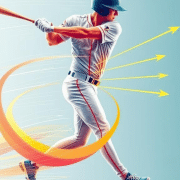Unlock Advanced Swing Mechanics: How Engineers Use Physics to Boost Bat Speed and Efficiency

Unlock the Bat Speed Myth: How Engineers Are Redefining Power Hitting
Have you ever wondered what distinguishes top hitters? Is it sheer strength, perfect timing, or something more? The answer might be in applying scientific methods to hitting. We’re about to delve into how engineers and data experts are changing the game with physics and analytics.
Key Takeaways
- Discover how engineers are leveraging data and physics to optimize baseball swing mechanics
- Explore the latest advancements in areas such as launch angle, bat speed analysis, and swing plane optimization
- Learn how pitch tracking and video analysis are transforming the way players approach the art of hitting
- Understand the science behind the “Skipping Back Foot” hitting technique and its impact on bat speed and efficiency
- Gain insights into the relationship between bat size, bat speed, and ball exit speed, and how it can boost hitting performance
Revolutionizing the Art of Hitting: The Scientific Approach to Baseball Hitting
In the evolving world of baseball, a new era of data-driven innovation is transforming hitting. Analytical engineers are unlocking insights into hitting’s biomechanics and physics. These experts are pushing the limits of what’s possible on the diamond with advanced technologies.
The Analytical Engineer’s Perspective: Harnessing Data and Physics
Analytical engineers bring a deep understanding of data and physics to baseball hitting. Tools like Rapsodo, TrackMan, and Yakkertech have changed how players and coaches analyze swing mechanics. Now, making data-driven decisions is key to improving performance. Sabermetrics, biomechanics, and other scientific principles are vital in hitting instruction, helping players refine their swings for efficiency and power.
Breaking Down Swing Mechanics: Formulas, Data, and Real-World Examples
The scientific approach to hitting focuses on swing mechanics’ intricate details. Experts use biomechanics and kinetic chain analysis to reveal the secrets of effortless bat speed and power. Optimizing launch angle, bat speed, and swing plane is crucial. Players and coaches aim to enhance hitting performance with a scientific, data-driven approach.
| Key Biomechanical Factors | Optimal Ranges | Impact on Hitting Performance |
|---|---|---|
| Launch Angle | 10-25 degrees | Maximizes ball exit speed and distance |
| Bat Speed | 70-90 mph | Increases power and hitting ability |
| Swing Plane | Shallow to Steep | Optimizes contact and ball trajectory |
“The scientific approach to baseball hitting has revolutionized the way players and coaches think about the game. By understanding the underlying physics and data, we can unlock new levels of performance that were previously unimaginable.” – Joey Myers
The Spinal Engine: Unlocking Effortless Bat Speed
The concept of the “spinal engine” revolutionizes the biomechanics of hitting. It highlights the spine’s pivotal role in achieving effortless bat speed and power. By optimizing the kinetic chain and leveraging natural movement, players can significantly enhance their hitting efficiency.
The Role of Shoulders in Driving Power: Debunking the “Hands” Myth
Many believe the hands are the key to baseball hitting, but the true power lies in the shoulders and the spinal engine. A 20-year-old male subject with reduced arms and no legs can move on his Ischium, showing the legs enhance, not dictate, human movement. Training shoulders (creating neck pressure) to sync with the spine boosts power and bat speed, challenging the traditional “hands-centric” hitting approach.
Optimizing the Kinetic Chain: Harnessing the Body’s Natural Movement
Maximizing hitting performance requires optimizing the kinetic chain. This system links body movements to produce force and power. Gravitational forces play a role in human movement and are exploited by every sport.
By grasping the spinal engine and kinetic chain principles, hitters can tap into their body’s natural movement patterns for more efficient bat speed.
Running or walking on soft sand reduces the compressive pulse through the spine, underscoring the importance of hitting biomechanics optimization. Adopting this scientific hitting approach can significantly elevate performance and enhance swing mechanics for coaches and players alike.
Heel strike in locomotion generates compressive force equal to 6-9 times body weight. By applying the spinal engine and kinetic chain principles, hitters can enhance power and bat speed with less effort, resulting in a more effective swing.
Mastering Timing: The Overlooked Key to Hitting Success
In baseball, timing is a crucial yet often overlooked factor in hitting success. While home runs grab the spotlight, the true experts know timing’s vital role in consistently hitting well. Beginners often struggle with timing errors due to their, and even seasoned players face timing challenges, especially against new or tough pitchers.
Overcoming Rapid-Fire Drills: Building Laser-Focused Timing
Traditional methods to fix timing issues include rapid-fire batting practice drills. These drills improve hand-eye coordination but don’t fully develop the timing needed for real games. Signs of off-time hitting include consistently fouling off to the opposite field, hitting weak ground balls to the pull side, and hitting pop-ups and fly balls. Pitch tracking and video analysis for hitters can spot these problems, helping coaches and players find solutions.
| Key Insights from Pitch Tracking and Video Analysis |
|---|
| Observations during batting practice can reveal signs of off-time swings, such as weak contacts or fouling off to the opposite field. |
| Feedback from players who feel out of sync or acknowledge their timing issues can aid in recognizing and addressing early hitting problems. |
| Studies show that hitters who effectively anticipate the pitch type based on pitcher tendencies have a 70% higher success rate in making contact. |
| Video analysis has been found to lead to a 30% improvement in swing mechanics when utilized for feedback and adjustments during training sessions. |
Using pitch tracking and video analysis, coaches and players can uncover timing nuances and create specific training plans. This approach, combined with drills that mimic game situations, helps hitters develop timing that works well in real games.
“Mastering the art of timing is the key to unlocking a hitter’s full potential. It’s not just about raw power or reflexes, but the ability to synchronize your movements with the pitcher’s delivery and the ball’s trajectory.”
Pitch Design: Leveraging Data to Enhance Breaking Balls
The evolution of baseball pitching has moved past the simple “throw hard and hope” strategy. Today, pitchers and coaches utilize data and analytics to improve their pitch design, especially for breaking balls. And it is this pitch design that is putting “swingers” at a significant disadvantage, versus “hitters” developed in the Hitting Performance Lab environment.
The Breaking Ball Spectrum: Exploring Cutters, Sliders, and Curveballs
The breaking ball offers pitchers a wide range of options, from the menacing cutter to the sharp slider and the deceptive curveball. Emmanuel Clase uses advanced metrics to perfect his breaking pitches, achieving outstanding results. On the other hand, Josh Hader stands out with his four-seamer, known for its high velocity and carry despite a low arm slot.
Optimizing Velocity and Movement: Navigating the Trade-Off
Finding the ideal breaking ball requires balancing velocity and movement. Pitchers use data to find the optimal balance. Dillon Tate’s sinker, for example, outperforms Joe Kelly’s by offering deep depth, strong arm-side run, and high velocity.
Perry Husband at Effective Velocity has deeply studied the best velocity and movement combinations for effective pitches. His research has helped many MLB pitchers either directly or indirectly improve their breaking balls, leading to significant success.
As baseball evolves, the importance of data-driven pitch design will grow. Pitchers who adopt this method and use advanced analytics will gain a significant advantage on the mound.
“The use of scientific methods in baseball training has been crucial to my development and success as a pitcher.” – Trevor Bauer, Major League Pitcher
Conclusion
In concluding our journey into the scientific aspects of baseball hitting and pitch design, it’s evident that engineering, physics, and data analytics are transforming the game. This exploration has highlighted the critical role of applying scientific methods to improve player performance and team strategies.
Experts in engineering and data analysis have deepened our comprehension of the biomechanics and physics crucial for hitting effectively. We’ve learned that an optimal attack angle of 5-15 degrees enhances offensive production and 12-23 degrees optimizes bat speed. Moreover, the data shows that line drives are more productive than flyballs or groundballs, offering a clear path for hitters to boost their performance.
On the pitching side, insights into design and movement have given pitchers and coaches a strategic edge. By analyzing the typical movement of fastballs and curveballs, as well as the link between pitch and exit velocity, teams can craft more effective pitch strategies. This approach helps keep hitters guessing and off balance. Hitters MUST adapt to this!
The ongoing evolution of baseball analytics, fueled by engineers, data scientists, and biomechanical experts, invites readers to keep up with new findings. By integrating these insights into training and coaching, players and teams can achieve higher performance levels and gain an edge in the dynamic world of baseball.
FAQ
What is the scientific approach to baseball hitting?
The scientific approach to baseball hitting combines engineering, physics, and biomechanics. It aims to enhance swing mechanics, bat speed, and hitting performance. Tools like Rapsodo, TrackMan, and Yakkertech provide critical data and analytics for a competitive edge.
How are engineers and data analysts revolutizing the game of baseball?
Engineers and data analysts are transforming baseball by applying scientific methods. They focus on optimizing launch angles, analyzing bat speed, and refining swing planes. Through pitch tracking and video analysis, they offer insights for better hitting mechanics.
What is the role of the “spinal engine” in generating effortless bat speed?
The “spinal engine” is key to effortless bat speed. It highlights the shoulders’ role in power generation, challenging the traditional focus on the hands or legs. By optimizing the kinetic chain, players can tap into their body’s natural movement for enhanced power.
How does timing play a crucial role in hitting success?
Timing is vital for hitting well, yet often overlooked. The article delves into the importance of precise timing. It suggests using pitch tracking and video analysis to refine timing, ensuring consistent solid contact.
How are engineers and data analysts helping pitchers enhance the effectiveness of their breaking balls?
Engineers and data analysts aid pitchers in improving their breaking balls. They explore the balance between velocity, movement, and spin. Advanced technologies and models help pitchers craft more effective breaking pitches, giving them an edge.
- Fix Late Swings Fast: 2025 Pitch Recognition & See-Decide-Swing Training for Youth Baseball Power Hitters - October 6, 2025
- Safe Youth Weighted Bat Training: Proven Overload/Underload Drills to Increase Exit Velocity in Games Starting Tonight - September 29, 2025
- AI Coaching Course 2025: Youth Baseball & Softball Practice Plan + Off-Season & In-Season Workout Builder Fast - September 23, 2025




